24 aug 2018
press crews who have been repeatedly attacked during their work near the border over the past weeks.
Since the launch of the Great March of Return on 30th March, 171 Palestinians have been killed, including 27 children, three girls, three paramedics, and two journalists.
Gaza Ministry of Health said that nine Palestinian youths were killed near the border fence during the same period and their bodies are currently detained by the IOF.
The Ministry added in a statement that at least 18,300 Palestinian citizens have been injured, including 3,600 children and 1,750 women.
Since the launch of the Great March of Return on 30th March, 171 Palestinians have been killed, including 27 children, three girls, three paramedics, and two journalists.
Gaza Ministry of Health said that nine Palestinian youths were killed near the border fence during the same period and their bodies are currently detained by the IOF.
The Ministry added in a statement that at least 18,300 Palestinian citizens have been injured, including 3,600 children and 1,750 women.
23 aug 2018
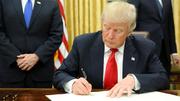
The head of a United Nations Human Rights Council commission to investigate crimes committed by Israel along the Gaza fence in recent months has resigned.
The council on Thursday confirmed that former war crimes prosecutor David Crane, an American who was named only last month to lead the UN investigation, resigned for "personal reasons".
The UN said in a statement dated Aug. 22 that Crane had informed the council of his decision a day earlier, "due to a personal circumstance that has arisen" and that the council was "considering next steps".
Vojislav Suc, Slovenian ambassador to the UN in Geneva and president of the council, has accepted the resignation and will have the task of appointing a new president.
The UN council voted in May to send a team of international war crimes investigators to probe the deadly shootings of Gaza protesters by Israeli forces.
Crane was named head of the three-person inquiry on July 25. The remaining members of the Commission of Inquiry are Sara Hossain of Bangladesh, and Kaari Betty Murungi of Kenya.
The commission is due to provide an update on its work to the council on Sept. 24.
Crane, recently retired as a Syracuse University professor, worked for decades for the US government, including as senior inspector general in the Department of Defense.
He also served as chief prosecutor of the Special Court for Sierra Leone in 2002-2005 and indicted the then Liberian leader Charles Taylor for war crimes.
Protests and clashes began on the Gaza-Israeli fence in March and have continued at varying levels since then.
More than 170 Palestinians have been killed by Israeli forces ever since protest rallies against the decades-long Israeli occupation of Palestinian lands began in the Gaza Strip on March 30.
On May 14, Israeli troops opened fire on Palestinians who had gathered near the Gaza fence in protest against the inauguration of the US embassy in Jerusalem al-Quds.
Over 60 Palestinians were shot dead and more than 2,700 wounded by Israeli snipers who had been positioned along the fence.
A total of 14,811 Palestinians have also sustained injuries, of whom 366 are reportedly in critical condition.
The Gaza Ministry of Health, in a recent report, announced that more than 18,000 Palestinians had sustained injuries, of whom 370 were paramedics.
The United Nations Children’s Fund (UNICEF) has said children in the Gaza Strip are the main victims of the Israeli atrocities, where some 1.8 million people are living under a crippling blockade.
Gaza has been under the Israeli siege since June 2007, causing a decline in living standards as well as unprecedented unemployment and poverty.
Israel has also launched several wars on the Palestinian sliver of land, the last of which began in early July 2014 and ended in late August the same year. The military aggression killed nearly 2,200 Palestinians and injured over 11,100 others.
The council on Thursday confirmed that former war crimes prosecutor David Crane, an American who was named only last month to lead the UN investigation, resigned for "personal reasons".
The UN said in a statement dated Aug. 22 that Crane had informed the council of his decision a day earlier, "due to a personal circumstance that has arisen" and that the council was "considering next steps".
Vojislav Suc, Slovenian ambassador to the UN in Geneva and president of the council, has accepted the resignation and will have the task of appointing a new president.
The UN council voted in May to send a team of international war crimes investigators to probe the deadly shootings of Gaza protesters by Israeli forces.
Crane was named head of the three-person inquiry on July 25. The remaining members of the Commission of Inquiry are Sara Hossain of Bangladesh, and Kaari Betty Murungi of Kenya.
The commission is due to provide an update on its work to the council on Sept. 24.
Crane, recently retired as a Syracuse University professor, worked for decades for the US government, including as senior inspector general in the Department of Defense.
He also served as chief prosecutor of the Special Court for Sierra Leone in 2002-2005 and indicted the then Liberian leader Charles Taylor for war crimes.
Protests and clashes began on the Gaza-Israeli fence in March and have continued at varying levels since then.
More than 170 Palestinians have been killed by Israeli forces ever since protest rallies against the decades-long Israeli occupation of Palestinian lands began in the Gaza Strip on March 30.
On May 14, Israeli troops opened fire on Palestinians who had gathered near the Gaza fence in protest against the inauguration of the US embassy in Jerusalem al-Quds.
Over 60 Palestinians were shot dead and more than 2,700 wounded by Israeli snipers who had been positioned along the fence.
A total of 14,811 Palestinians have also sustained injuries, of whom 366 are reportedly in critical condition.
The Gaza Ministry of Health, in a recent report, announced that more than 18,000 Palestinians had sustained injuries, of whom 370 were paramedics.
The United Nations Children’s Fund (UNICEF) has said children in the Gaza Strip are the main victims of the Israeli atrocities, where some 1.8 million people are living under a crippling blockade.
Gaza has been under the Israeli siege since June 2007, causing a decline in living standards as well as unprecedented unemployment and poverty.
Israel has also launched several wars on the Palestinian sliver of land, the last of which began in early July 2014 and ended in late August the same year. The military aggression killed nearly 2,200 Palestinians and injured over 11,100 others.
22 aug 2018
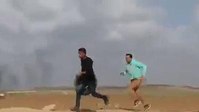
Following army's decision to launch probe into the killing of two Palestinians during the 'March of Return' protests, some 10 soldiers—including veterans and high-ranking officers—will testify or be questioned under caution; Military Police will also try to obtain testimonies from Palestinians.
Around 10 Israeli soldiers, including snipers and company commanders, are expected to testify or be questioned under caution in the coming weeks, as part of an IDF investigation that was announced on Tuesday into two incidents in which Palestinians youths were killed on the Gaza border fence during violent demonstrations.
The soldiers who are set to be called in for questioning belong to the Nahal and Givati brigades, along with Border Police snipers stationed at the Gaza border at the beginning of the 'March of Return' violent protests.
Authorities hope that their testimonies will shed light on the identity of the soldier who shot Osman Rami Hills, a 16-year-old Palestinian, near the fence last month.
The investigation will be conducted by the operational investigations unit in the Military Police Criminal Investigation Division (MPCID). The unit is responsible for the investigations of incidents in operational circumstances only.
Some of the soldiers who will be questioned are army veterans. Senior officers who serve as battalion or brigade commanders will also testify, but for the time being, they are not expected to be questioned under caution.
The MPCID will also investigate a shooting incident in which a sniper unit shot two Palestinians at the border at the end of March. The shooting was carried out with the approval of the sector's senior officer, who is usually the commander of the battalion or the regional brigade, and in accordance with the army's rules of engagement and regulations on opening fire.
The investigation will be conducted under the supervision of the Military Advocate General's Office whose representatives are familiar with the details of the investigation.
The decision to open a criminal probe into the matter was based on information that has been acquired by the IDF in recent months.
The MPCID will also try to obtain testimonies from Palestinians who took part in the demonstrations when the incidents occured, as well as reports or testimonies of representatives of international organizations operating in Gaza.
The first probe relates to an incident that occurred at the end of March 30 next to the security fence east of Jabalia on March 30 when 18-year-old Abdel Fattah Abdel Nabi was killed.
Nabi's death made international headlines fter he was seen retreating with another young Palestinian from the perimeter area (the buffer zone between the Gaza Strip and the border fence) towards other demonstrators, and being shot in the back by a sniper.
The second probe relates to the aforementioned incident that took place near the Karni crossing on July 13 in which Osman Rami Hills was shot near the fence by a force from the IDF's Givati Brigade. Hills was seen climbing the fence when he was shot, and the shooting was apparently not carried out by a sniper.
"The decision was made after examining the command debriefings, the findings of the General Staff's debriefing mechanism, and the information received by the IDF, following a suspicion that the shooting in these incidents was not in accordance with standard operating procedures," the IDF Spokesperson's Unit said.
"The findings will be examined by the Military Advocate General, and the General Staff's debriefing mechanism, led by Brig. Gen. Moti Baruch, examined all Gaza border incidents, codenamed in the IDF as "Gatekeepers' Alert," the statement concluded.
Around 10 Israeli soldiers, including snipers and company commanders, are expected to testify or be questioned under caution in the coming weeks, as part of an IDF investigation that was announced on Tuesday into two incidents in which Palestinians youths were killed on the Gaza border fence during violent demonstrations.
The soldiers who are set to be called in for questioning belong to the Nahal and Givati brigades, along with Border Police snipers stationed at the Gaza border at the beginning of the 'March of Return' violent protests.
Authorities hope that their testimonies will shed light on the identity of the soldier who shot Osman Rami Hills, a 16-year-old Palestinian, near the fence last month.
The investigation will be conducted by the operational investigations unit in the Military Police Criminal Investigation Division (MPCID). The unit is responsible for the investigations of incidents in operational circumstances only.
Some of the soldiers who will be questioned are army veterans. Senior officers who serve as battalion or brigade commanders will also testify, but for the time being, they are not expected to be questioned under caution.
The MPCID will also investigate a shooting incident in which a sniper unit shot two Palestinians at the border at the end of March. The shooting was carried out with the approval of the sector's senior officer, who is usually the commander of the battalion or the regional brigade, and in accordance with the army's rules of engagement and regulations on opening fire.
The investigation will be conducted under the supervision of the Military Advocate General's Office whose representatives are familiar with the details of the investigation.
The decision to open a criminal probe into the matter was based on information that has been acquired by the IDF in recent months.
The MPCID will also try to obtain testimonies from Palestinians who took part in the demonstrations when the incidents occured, as well as reports or testimonies of representatives of international organizations operating in Gaza.
The first probe relates to an incident that occurred at the end of March 30 next to the security fence east of Jabalia on March 30 when 18-year-old Abdel Fattah Abdel Nabi was killed.
Nabi's death made international headlines fter he was seen retreating with another young Palestinian from the perimeter area (the buffer zone between the Gaza Strip and the border fence) towards other demonstrators, and being shot in the back by a sniper.
The second probe relates to the aforementioned incident that took place near the Karni crossing on July 13 in which Osman Rami Hills was shot near the fence by a force from the IDF's Givati Brigade. Hills was seen climbing the fence when he was shot, and the shooting was apparently not carried out by a sniper.
"The decision was made after examining the command debriefings, the findings of the General Staff's debriefing mechanism, and the information received by the IDF, following a suspicion that the shooting in these incidents was not in accordance with standard operating procedures," the IDF Spokesperson's Unit said.
"The findings will be examined by the Military Advocate General, and the General Staff's debriefing mechanism, led by Brig. Gen. Moti Baruch, examined all Gaza border incidents, codenamed in the IDF as "Gatekeepers' Alert," the statement concluded.
21 aug 2018
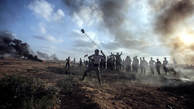
The army will investigate two incidents that took place during the 'March of Return' protests; the first in March, involving 18-year-old protester who was shot while running away from the border; the second relates to a July incident in which a 16-year-old Palestinian boy was shot near the fence by a Givati force.
The Military Advocate General's Office announced on Tuesday that the IDF will launch a criminal investigation into shooting incidents in which Palestinian youths were killed on the Gaza border fence in recent months.
The probe will examine two incidents. The first took place in March, when an 18-year-old demonstrator was shot in the back while running away from the border fence and towards Gaza. The second, an incident in which a 16-year-old Palestinian boy was shot while standing near the border fence in July.
In March, 18-year-old Abdel Fattah Abdel Nabi was seen retreating with another young Palestinian from the perimeter area (the buffer zone between the Gaza Strip and the border fence) towards other demonstrators, and was shot by a sniper with his back turned to the IDF forces.
A video of the incident shows a Palestinian protester holding a tire and running away from the border fence towards the Gaza Strip. Nabi is seen at his side, taking the tire from him.
The video then shows Nabi running away from the fence, getting hit and dropping to the ground. The video does not show Nabi's actions before his retreat. Other protesters evacuated him from the area.
In its first statement after the incident, the IDF said that "Hamas distributes various videos, including those that only show parts of events, edited and fabricated. Our forces acted according to the rules of engagement in a level-headed manner, while refraining from harming civilians whom Hamas placed on the front lines in order to embarrass Israel while endangering those civilians."
"It is the IDF's use of force that prevented a mass violation of Israeli sovereignty and a scenario in which security infrastructures are destroyed. We advise against taking Hamas's propaganda as fact," the statement read.
The second probe relates to an incident in which Osman Rami Hills, a 16-year-old Palestinian boy, was shot near the fence by a force from the IDF's Givati Brigade.
The IDF Spokesperson stated on Tuesday that "the Chief Military Advocate General, Maj. Gen. Sharon Afek, ordered a military police investigation into two incidents in which Palestinians were shot in the Gaza Strip by IDF forces. The first incident is the death of Abdel Fattah Abdel Nabi from IDF gunfire near the security fence east of Jabalia on March 30. The second incident involves the death of Osman Rami Hills from IDF gunfire near the security fence in the Karni crossing on July 13."
"The decision was made after examining the command debriefings, the findings of the General Staff's debriefing mechanism, and the information received by the IDF, following a suspicion that the shooting in these incidents was not in accordance with standard operating procedures. The findings will be examined by the Military Advocate General," the IDF Spokesperson added.
The General Staff's debriefing mechanism, led by Brig. Gen. Moti Baruch, examined all Gaza border incidents, codenamed in the IDF as "Gatekeepers' Alert."
The Military Advocate General's Office announced on Tuesday that the IDF will launch a criminal investigation into shooting incidents in which Palestinian youths were killed on the Gaza border fence in recent months.
The probe will examine two incidents. The first took place in March, when an 18-year-old demonstrator was shot in the back while running away from the border fence and towards Gaza. The second, an incident in which a 16-year-old Palestinian boy was shot while standing near the border fence in July.
In March, 18-year-old Abdel Fattah Abdel Nabi was seen retreating with another young Palestinian from the perimeter area (the buffer zone between the Gaza Strip and the border fence) towards other demonstrators, and was shot by a sniper with his back turned to the IDF forces.
A video of the incident shows a Palestinian protester holding a tire and running away from the border fence towards the Gaza Strip. Nabi is seen at his side, taking the tire from him.
The video then shows Nabi running away from the fence, getting hit and dropping to the ground. The video does not show Nabi's actions before his retreat. Other protesters evacuated him from the area.
In its first statement after the incident, the IDF said that "Hamas distributes various videos, including those that only show parts of events, edited and fabricated. Our forces acted according to the rules of engagement in a level-headed manner, while refraining from harming civilians whom Hamas placed on the front lines in order to embarrass Israel while endangering those civilians."
"It is the IDF's use of force that prevented a mass violation of Israeli sovereignty and a scenario in which security infrastructures are destroyed. We advise against taking Hamas's propaganda as fact," the statement read.
The second probe relates to an incident in which Osman Rami Hills, a 16-year-old Palestinian boy, was shot near the fence by a force from the IDF's Givati Brigade.
The IDF Spokesperson stated on Tuesday that "the Chief Military Advocate General, Maj. Gen. Sharon Afek, ordered a military police investigation into two incidents in which Palestinians were shot in the Gaza Strip by IDF forces. The first incident is the death of Abdel Fattah Abdel Nabi from IDF gunfire near the security fence east of Jabalia on March 30. The second incident involves the death of Osman Rami Hills from IDF gunfire near the security fence in the Karni crossing on July 13."
"The decision was made after examining the command debriefings, the findings of the General Staff's debriefing mechanism, and the information received by the IDF, following a suspicion that the shooting in these incidents was not in accordance with standard operating procedures. The findings will be examined by the Military Advocate General," the IDF Spokesperson added.
The General Staff's debriefing mechanism, led by Brig. Gen. Moti Baruch, examined all Gaza border incidents, codenamed in the IDF as "Gatekeepers' Alert."
17 aug 2018
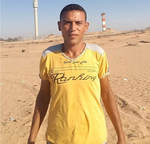
Saadi Akram Moamer, 26
Israeli forces opened fire on protests in the Gaza Strip on Friday, killing at least two Palestinians and injuring dozens more.
Gaza's Ministry of Health said two Palestinians were killed and over 270 injured as Israeli soldiers opened fire on demonstrations calling for the right of return for Palestinian refugees.
The ministry named one man as Karim Abu Fatayer, 30, and said he was shot near the central Gaza Strip town of Bureij.
The second was named as Saadi Akram Moamer, 26, who was shot east of Rafah.
Over 40 Palestinians were injured by live fire.
At least 160 Palestinians have been killed since the Great Return March protests began on 30 March, with more than 17,500 injured.
More than 68 Palestinians injured by Israeli forces have required amputations of either lower or upper limbs since protests began.
Palestinians are calling to return to the homes their families were forced from in 1948, during the war surrounding the creation of Israel.
Protesters have also called for an end to the decade-long crippling blockade on the Palestinian enclave.
Israel says its use of live fire is necessary to defend its borders and stop infiltrations, but human rights groups accuse it of disproportionate force against unarmed protesters.
Gaza has been under an Israeli blockade for over a decade, with residents banned from leaving the besieged coastal enclave.
Israeli forces opened fire on protests in the Gaza Strip on Friday, killing at least two Palestinians and injuring dozens more.
Gaza's Ministry of Health said two Palestinians were killed and over 270 injured as Israeli soldiers opened fire on demonstrations calling for the right of return for Palestinian refugees.
The ministry named one man as Karim Abu Fatayer, 30, and said he was shot near the central Gaza Strip town of Bureij.
The second was named as Saadi Akram Moamer, 26, who was shot east of Rafah.
Over 40 Palestinians were injured by live fire.
At least 160 Palestinians have been killed since the Great Return March protests began on 30 March, with more than 17,500 injured.
More than 68 Palestinians injured by Israeli forces have required amputations of either lower or upper limbs since protests began.
Palestinians are calling to return to the homes their families were forced from in 1948, during the war surrounding the creation of Israel.
Protesters have also called for an end to the decade-long crippling blockade on the Palestinian enclave.
Israel says its use of live fire is necessary to defend its borders and stop infiltrations, but human rights groups accuse it of disproportionate force against unarmed protesters.
Gaza has been under an Israeli blockade for over a decade, with residents banned from leaving the besieged coastal enclave.
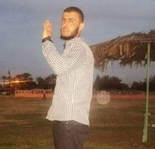
Karim Abul-Fatayer, 30
At least one Palestinian man was killed and 156 others injured, by live bullets or sustained suffocation from teargas inhalation, on Friday, as Israeli forces continued to crack down on the Great March of Return protests at Gaza-Israel border, according to the Ministry of Health. video
The forces fired live bullets and rubber-coated steel rounds at the protesters who gathered at many encampments along the border, killing Karim Abul-Fatayer, 30, and injuring 156 other protesters, WAFA reported.
More than 169 Palestinians have been killed and 17,500 others injured since the outbreak of the Gaza border protests on March 30. The protests call for ending the 12-year-long Israeli blockade of Gaza and for the right of return of the refugees.
Most of the casualties occurred on May 14, when Israeli forces attacked Palestinian protesters marking the 70th anniversary of Israel’s occupation of historical Palestine and the ensuing ethnic cleansing of half a million Palestinian refugees.
At least one Palestinian man was killed and 156 others injured, by live bullets or sustained suffocation from teargas inhalation, on Friday, as Israeli forces continued to crack down on the Great March of Return protests at Gaza-Israel border, according to the Ministry of Health. video
The forces fired live bullets and rubber-coated steel rounds at the protesters who gathered at many encampments along the border, killing Karim Abul-Fatayer, 30, and injuring 156 other protesters, WAFA reported.
More than 169 Palestinians have been killed and 17,500 others injured since the outbreak of the Gaza border protests on March 30. The protests call for ending the 12-year-long Israeli blockade of Gaza and for the right of return of the refugees.
Most of the casualties occurred on May 14, when Israeli forces attacked Palestinian protesters marking the 70th anniversary of Israel’s occupation of historical Palestine and the ensuing ethnic cleansing of half a million Palestinian refugees.
15 aug 2018
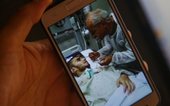
In the 22 years of Sari al-Shobaki’s life, his father rescued him from death seven times, but the eighth time, when he was shot by the Israeli occupied snipers, he failed.
The first time, Dr Dahoud al-Shobaki recalls, was when his son was born three months premature and turned blue from lack of oxygen in an incubator. Then there was also the time when he had a dangerously high fever at age four.
But, the last five occurred in the span of two months this year.
“I wish that I had been able to save my son’s life like I am used to … but the eighth time, it was God’s decree,” Dahoud tells Middle East Eye.
As a retired doctor now turned public health consultant in the Gaza Strip, Dahoud, 56, knows the difficulties faced by wounded and sick patients in the besieged Palestinian enclave’s hospitals.
But despite the health scares he has faced over the years, nothing prepared Dahoud to witness first-hand the slow death of his son Sari, shot in the neck by Israeli soldiers in May, only to succumb to his wounds two months later.
Left to die
At only 22, Sari al-Shobaki dreamt of getting married and becoming a father. An enterprising young man, he worked hard to make his dream come true, working a series of odd jobs such as selling cold drinks and stockings or working at a photography studio.
The second-eldest of eight children, Sari used his earnings to help out his family in the Daraj neighbourhood of Gaza City and to try to build a future for himself.
At 10am on 14 May, the young man walked out of the house without telling his family where he was going. What exactly transpired then remains a mystery to his family until now.
Dahoud’s phone rang an hour after Sari left home.
On the other end of the line, someone told him that his beloved son had been killed by Israeli soldiers in Gaza’s buffer zone near Israel.
That fateful Monday ended up being the single bloodiest day of the Great March of Return. Since 30 March, thousands of Palestinians have protested against living conditions in Gaza and called for the right of return for those Palestinian refugees whose families were displaced during the establishment of Israel.
At least 58 died on 14 May after Israeli forces opened fire, with a further seven Palestinians later dying from injuries sustained that day. Many had come out to denounce the inauguration of the US embassy in Jerusalem, which happened on the same day.
Dahoud rushed to the al-Shifa hospital in Gaza City, which was overwhelmed that day with casualties from the protest. The medical authorities did not have anyone registered under Sari’s name, so Dahoud combed every department of the medical centre for hours.
Amid the chaos, he finally found his son lying in a corner of the reception area. On his chest lay a piece of paper marked “Unidentified”. He was in dire straits, but still breathing.
Father and doctor
Dahoud could barely control his emotions when he saw that no one was providing his son with medical care.
“Oh Sari, how many hours you have been bleeding alone? Is this what you deserve?” he remembers asking.
Dahoud immediately took matters into his own hands and saved his son’s life for a third time, transfusing 12 units of blood and infusing more than 100 saline solution units.
Sari stabilised, but the bullet that penetrated his neck had hit his spinal cord, rendering him quadriplegic and leaving him with respiratory and intestinal paralysis.
After 10 days at the al-Shifa hospital, all the doctors who examined Sari agreed that his condition was irreversible, especially given the limited medical care available in Gaza, where extensive power cuts and a shortage of medical supplies due to the 11-year Israeli siege have devastated its health sector.
Dahoud, like many desperate relatives in Gaza, tried hard to find care for his son outside the enclave, a difficult process given the small number of medical exit permits granted by Israel to Palestinian patients.
Finally, on 25 May, Dahoud and Sari were allowed to travel to East Jerusalem for treatment at the Saint Joseph hospital.
Hopeful recovery
Despite the diagnosis and the lack of proper medical care in Gaza, Dahoud did not lose hope.
Father and son began communicating through eye contact: Sari would blink to say “yes” and raise his eyebrows to signify “no”.
“I will be happy even with only your eyes with me, even without your body,” Dahoud recalls saying. “I do not ask for more.”
Soon, the two devised a more elaborate system of communication. Dahoud would recite the alphabet, and Sari would blink when he reached the desired letter, slowly spelling out his sentences.
Dahoud would warmly encourage his son through rehabilitation exercises. Some sessions were filmed and posted online, prompting waves of support on social media.
“One more time, love of my life, do you want to get out of here?” he would say, kissing Sari’s forehead as the young man would blink once for “yes”.
Between 5 June and 5 July, Sari made a slow but promising recovery in the East Jerusalem hospital, Dahoud says, as he kept up his involvement in his son’s treatment.
“I was checking on everything, even on his breath. I would massage him for three hours or more every day until I noticed that he was trying to move his neck,” Dahoud says.
“He regained his sense of smell, and was able to defecate and speak again,” Dahoud says. “He also moved the muscles of his stomach and thigh, and moved his knee when I pulled it.”
Dahoud could not believe the great improvements made by his son.
He remembers kissing Sari and telling him: “We will not go back to Gaza until you can stand on your feet.”
Sari had replied: “I want to stand up. I want to walk, dad.”
Sari’s last days
But just as his condition looked hopeful, Sari’s health took a drastic turn for the worse.
A tracheostomy operation to insert a tube into Sari’s neck to help him breathe did not go as planned, causing a tracheoesophagal fistula – an abnormal connection between his oesophagus and windpipe – and a drug-resistant bacterial infection.
The fistula made it impossible for Sari to eat. Dahoud watched helplessly as his son withered away, knowing that he was hungry and thirsty yet unable to satisfy these basic needs.
On 17 July, slightly more than two months after he was shot, Sari al-Shobaki died.
“When Sari passed away, he hadn’t seen a single tear from my eye,” Dahoud says. “When I was with him, I held myself together completely. And I was strong, very strong. And I’m really happy about this, that Sari never saw me cry.
“Sari’s spirits were as high as the sky, while my spirits were as low as the ground. I would leave him in the intensive care unit and go the waiting room to break down in tears,” Dahoud adds, his voice cracking.
According to the Gaza health ministry, Sari was the 142nd Palestinian to be killed by Israeli forces in Gaza since the beginning of the Great March of Return.
At least 25 more Palestinians have been killed in Gaza since, according to ministry figures.
“It makes me and the world proud that he didn’t get injured and die because of a brawl or a fight,” Dahoud says. “No, he got injured by the enemy.”
Despite the heartbreak and the grief, Dahoud vowed to move forward.
“I’m really happy that I was the one taking care of him and not anyone else,” he says. “I will return to my job as a doctor stronger than before.”
~Middle East Eye/Days of Palestine
The first time, Dr Dahoud al-Shobaki recalls, was when his son was born three months premature and turned blue from lack of oxygen in an incubator. Then there was also the time when he had a dangerously high fever at age four.
But, the last five occurred in the span of two months this year.
“I wish that I had been able to save my son’s life like I am used to … but the eighth time, it was God’s decree,” Dahoud tells Middle East Eye.
As a retired doctor now turned public health consultant in the Gaza Strip, Dahoud, 56, knows the difficulties faced by wounded and sick patients in the besieged Palestinian enclave’s hospitals.
But despite the health scares he has faced over the years, nothing prepared Dahoud to witness first-hand the slow death of his son Sari, shot in the neck by Israeli soldiers in May, only to succumb to his wounds two months later.
Left to die
At only 22, Sari al-Shobaki dreamt of getting married and becoming a father. An enterprising young man, he worked hard to make his dream come true, working a series of odd jobs such as selling cold drinks and stockings or working at a photography studio.
The second-eldest of eight children, Sari used his earnings to help out his family in the Daraj neighbourhood of Gaza City and to try to build a future for himself.
At 10am on 14 May, the young man walked out of the house without telling his family where he was going. What exactly transpired then remains a mystery to his family until now.
Dahoud’s phone rang an hour after Sari left home.
On the other end of the line, someone told him that his beloved son had been killed by Israeli soldiers in Gaza’s buffer zone near Israel.
That fateful Monday ended up being the single bloodiest day of the Great March of Return. Since 30 March, thousands of Palestinians have protested against living conditions in Gaza and called for the right of return for those Palestinian refugees whose families were displaced during the establishment of Israel.
At least 58 died on 14 May after Israeli forces opened fire, with a further seven Palestinians later dying from injuries sustained that day. Many had come out to denounce the inauguration of the US embassy in Jerusalem, which happened on the same day.
Dahoud rushed to the al-Shifa hospital in Gaza City, which was overwhelmed that day with casualties from the protest. The medical authorities did not have anyone registered under Sari’s name, so Dahoud combed every department of the medical centre for hours.
Amid the chaos, he finally found his son lying in a corner of the reception area. On his chest lay a piece of paper marked “Unidentified”. He was in dire straits, but still breathing.
Father and doctor
Dahoud could barely control his emotions when he saw that no one was providing his son with medical care.
“Oh Sari, how many hours you have been bleeding alone? Is this what you deserve?” he remembers asking.
Dahoud immediately took matters into his own hands and saved his son’s life for a third time, transfusing 12 units of blood and infusing more than 100 saline solution units.
Sari stabilised, but the bullet that penetrated his neck had hit his spinal cord, rendering him quadriplegic and leaving him with respiratory and intestinal paralysis.
After 10 days at the al-Shifa hospital, all the doctors who examined Sari agreed that his condition was irreversible, especially given the limited medical care available in Gaza, where extensive power cuts and a shortage of medical supplies due to the 11-year Israeli siege have devastated its health sector.
Dahoud, like many desperate relatives in Gaza, tried hard to find care for his son outside the enclave, a difficult process given the small number of medical exit permits granted by Israel to Palestinian patients.
Finally, on 25 May, Dahoud and Sari were allowed to travel to East Jerusalem for treatment at the Saint Joseph hospital.
Hopeful recovery
Despite the diagnosis and the lack of proper medical care in Gaza, Dahoud did not lose hope.
Father and son began communicating through eye contact: Sari would blink to say “yes” and raise his eyebrows to signify “no”.
“I will be happy even with only your eyes with me, even without your body,” Dahoud recalls saying. “I do not ask for more.”
Soon, the two devised a more elaborate system of communication. Dahoud would recite the alphabet, and Sari would blink when he reached the desired letter, slowly spelling out his sentences.
Dahoud would warmly encourage his son through rehabilitation exercises. Some sessions were filmed and posted online, prompting waves of support on social media.
“One more time, love of my life, do you want to get out of here?” he would say, kissing Sari’s forehead as the young man would blink once for “yes”.
Between 5 June and 5 July, Sari made a slow but promising recovery in the East Jerusalem hospital, Dahoud says, as he kept up his involvement in his son’s treatment.
“I was checking on everything, even on his breath. I would massage him for three hours or more every day until I noticed that he was trying to move his neck,” Dahoud says.
“He regained his sense of smell, and was able to defecate and speak again,” Dahoud says. “He also moved the muscles of his stomach and thigh, and moved his knee when I pulled it.”
Dahoud could not believe the great improvements made by his son.
He remembers kissing Sari and telling him: “We will not go back to Gaza until you can stand on your feet.”
Sari had replied: “I want to stand up. I want to walk, dad.”
Sari’s last days
But just as his condition looked hopeful, Sari’s health took a drastic turn for the worse.
A tracheostomy operation to insert a tube into Sari’s neck to help him breathe did not go as planned, causing a tracheoesophagal fistula – an abnormal connection between his oesophagus and windpipe – and a drug-resistant bacterial infection.
The fistula made it impossible for Sari to eat. Dahoud watched helplessly as his son withered away, knowing that he was hungry and thirsty yet unable to satisfy these basic needs.
On 17 July, slightly more than two months after he was shot, Sari al-Shobaki died.
“When Sari passed away, he hadn’t seen a single tear from my eye,” Dahoud says. “When I was with him, I held myself together completely. And I was strong, very strong. And I’m really happy about this, that Sari never saw me cry.
“Sari’s spirits were as high as the sky, while my spirits were as low as the ground. I would leave him in the intensive care unit and go the waiting room to break down in tears,” Dahoud adds, his voice cracking.
According to the Gaza health ministry, Sari was the 142nd Palestinian to be killed by Israeli forces in Gaza since the beginning of the Great March of Return.
At least 25 more Palestinians have been killed in Gaza since, according to ministry figures.
“It makes me and the world proud that he didn’t get injured and die because of a brawl or a fight,” Dahoud says. “No, he got injured by the enemy.”
Despite the heartbreak and the grief, Dahoud vowed to move forward.
“I’m really happy that I was the one taking care of him and not anyone else,” he says. “I will return to my job as a doctor stronger than before.”
~Middle East Eye/Days of Palestine
14 aug 2018
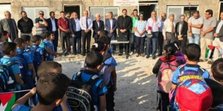
A Palestinian child was injured Tuesday evening when Israeli occupation forces (IOF) opened fire at a group of Palestinian citizens near the border east of Gaza city.
A medical source said that a child was wounded in the head by shrapnel from a live bullet while he was standing close to the Great March of Return camps east of Gaza.
Eyewitnesses said that the child was injured when the IOF heavily opened fire at a group of peaceful protesters near Gaza's eastern border fence.
Since the start of Gaza border protests on 30th March, 176 Palestinians have been killed by the IOF and over 18,000 injured.
A medical source said that a child was wounded in the head by shrapnel from a live bullet while he was standing close to the Great March of Return camps east of Gaza.
Eyewitnesses said that the child was injured when the IOF heavily opened fire at a group of peaceful protesters near Gaza's eastern border fence.
Since the start of Gaza border protests on 30th March, 176 Palestinians have been killed by the IOF and over 18,000 injured.
13 aug 2018
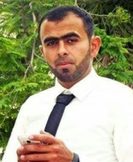
Wisam Yousef Hijazi, 30
Palestinian Medical sources in the Gaza Strip have reported that a seriously injured young man has died from his wounds, on Sunday at night.
The sources said that Wisam Yousef Hijazi, 30, was shot by Israeli army fire on May 14th, during the Great Return March procession, east of Abasan al-Jadeeda town, east of Khan Younis, in the southern part of the Gaza Strip.
Hijazi remained in a critical condition due to his injury, and was referred to an Egyptian hospital, but succumbed to his wounds at Rafah Border Terminal, between Gaza and Egypt.
Wisam was from Bani Sohelia town, east of Khan Younis.
According to data from the United Nations Office for the Coordination of Humanitarian Affairs in the Occupied Palestinian Territory (OCHA), published on August 9th 2018, 172 Palestinians; including 140 men, 2 women, 28 boys (children) and 2 girls (children), have been killed in the Gaza Strip since March 30th
It said that the soldiers have injured 17.504 Palestinians, including 9227 who were hospitalized, and 8277 who were treated in field clinics.
According to OCHA, the fatalities include 124 Palestinians who were killed during the protests, and 48 killed in “other
circumstances”; among the latter are seven people whose bodies are reportedly being withheld by the Israeli authorities.
However, on Saturday, August 11th, (prior to Hijazi’s death), Dr. Ashraf al-Qedra, the Head of the Public Relations Department on Gaza’s Health Ministry, has reported that the soldiers have killed 167 Palestinians, including three medics, during the Great Return March Procession, since it started on March 30th, 2018.
He added that the soldiers have injured approximately 18.000 Palestinians, including 370 medics, and caused damage to 70 ambulances, since March 30th.
Palestinian Medical sources in the Gaza Strip have reported that a seriously injured young man has died from his wounds, on Sunday at night.
The sources said that Wisam Yousef Hijazi, 30, was shot by Israeli army fire on May 14th, during the Great Return March procession, east of Abasan al-Jadeeda town, east of Khan Younis, in the southern part of the Gaza Strip.
Hijazi remained in a critical condition due to his injury, and was referred to an Egyptian hospital, but succumbed to his wounds at Rafah Border Terminal, between Gaza and Egypt.
Wisam was from Bani Sohelia town, east of Khan Younis.
According to data from the United Nations Office for the Coordination of Humanitarian Affairs in the Occupied Palestinian Territory (OCHA), published on August 9th 2018, 172 Palestinians; including 140 men, 2 women, 28 boys (children) and 2 girls (children), have been killed in the Gaza Strip since March 30th
It said that the soldiers have injured 17.504 Palestinians, including 9227 who were hospitalized, and 8277 who were treated in field clinics.
According to OCHA, the fatalities include 124 Palestinians who were killed during the protests, and 48 killed in “other
circumstances”; among the latter are seven people whose bodies are reportedly being withheld by the Israeli authorities.
However, on Saturday, August 11th, (prior to Hijazi’s death), Dr. Ashraf al-Qedra, the Head of the Public Relations Department on Gaza’s Health Ministry, has reported that the soldiers have killed 167 Palestinians, including three medics, during the Great Return March Procession, since it started on March 30th, 2018.
He added that the soldiers have injured approximately 18.000 Palestinians, including 370 medics, and caused damage to 70 ambulances, since March 30th.
Page: 42 - 41 - 40 - 39 - 38 - 37 - 36 - 35 - 34 - 33 - 32 - 31 - 30 - 29 - 28 - 27 - 26 - 25 - 24 - 23 - 22 - 21

